View l from the mouth
The cheekbones are added.
For the full story see Endangered Knowledge: The Soul of Humus
Your Custom Text Here

View l from the mouth

The cheekbones are added.
For the full story see Endangered Knowledge: The Soul of Humus
My favorite measuring tool when building the armature is a sewing tape measure.


For the full story see Endangered Knowledge: The Soul of Humus
The head is a lot of detail work. Bending small pieces of steel takes time and strength. It is easy to bend large pieces of steel because I can use leverage to bend it. Small parts are too short To get much lecerage. This is the first time in my life strength is an issue., I have not been doing my regular weight lifting due to COVID 19 quarantine. So I have to think of creative ways to make the shapes I need. It takes longer to figure out.

Examining this work I have decided I need to raise the left horn.
I have only welded the horn in one location. This will make it easier to correctly position the horn once the head is connected to the body. I can find them if I want, or I can cut the one weld and resend them in the correct position.

I moved the horn and added the front of the upper jaw.

I added the back of the upper jaw and two pieces to stabilize the head. The stabilizing pieces run through the center of the head, the length of the face to the back If the skull. I used the angle grinder to separate the front and left sides of the front jaw separating the two stabilizing pieces. This will make it easier to make any adjustments in the head structure when it is finished and attached to the body.
The skin and coat of the finished piece is the most crucial part if this piece. This steel armature is purely structural.
For the full story see Endangered Knowledge: The Soul of Humus

I have cut the steel for two sets of horns, the center of the face, top of the scull and part of the nisee. .
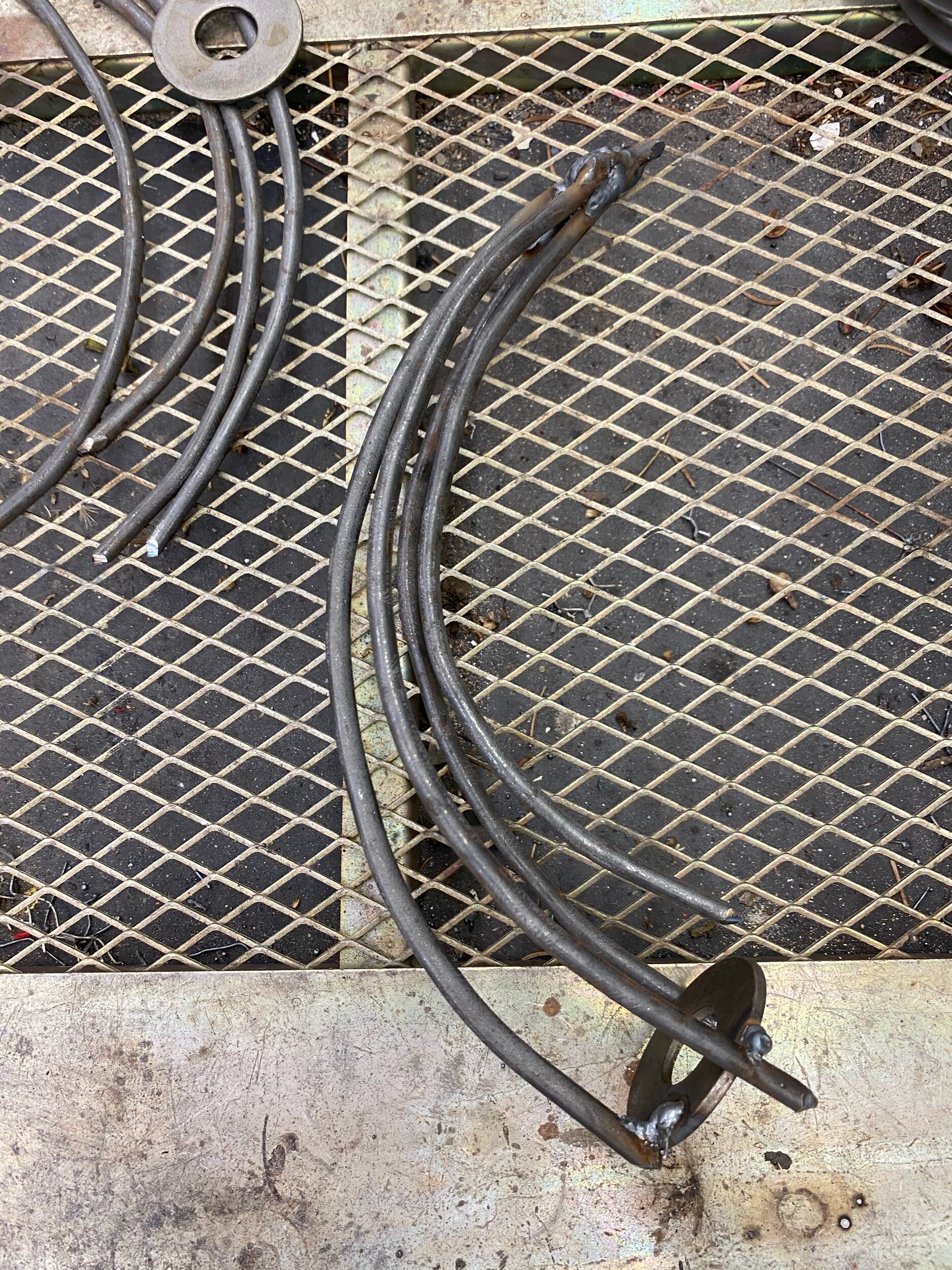
Working on the horns

This bison skull was a Christmas present. From Griffin and Alex my son and daughter in law. They have been unbelievably supportive of my environmental works. They are the best. The skull is proving extremely helpful in figuring out how to build the head armature.
For the Full story see Endangered Knowledge: The Soul of Humus
One of the most critical problems to solve is the placement of the hooves. They will be welded to Steel plates that act as the base. The base serves several purposes; it will make it easier to transport the piece without damaging it, it will make working on a large piece safer and less likely to fall on me. I am going to use 4 - 14” X 14” 1/4” steele plates. One for each hoove. This will give me the flexibility to adjust the placement of the hooves as the piece develops.

I am sending the hooves to Blumenthal metal and having them weld the hooves to the plates. It is tricky welding to a thin plate and not warping the plate.
Why is this important to me? Please see Endangered Knowledge: The Soul of Humus
It does not stand to reason that gardens or yards in Texas, Maryland, California, Iowa, and Illinois should all be landscaped with the same selection of plants. The below image from Native Texas Gardens says it all. In a country with great diversity from coast to coast, shouldn’t the sculpture garden landscapes be embedded in plants that define the place?
It will be more interesting to see sculptures in gardens of indigenous plants, plants that define the place, terrains that have attracted its people and impacted its economy. A sculpture of a boat marooned in a desert landscape might imply global warming and the same wooden vessel docked in a sea of woody pines congers up thoughts of concervation. one thing the same boat Sculpture changes across geography. What does sculpture look like in a coastal prairie sculpture garden?

Page xviv of Native Texas Gardens, maximum beauty, minimum upkeep by Sally and Andy Wasowski.

I am in love with these textures and I can hardly wait to incorporate them into my Endangered Knowledge piece. I do need to figure out how to fade the green out. I do not want a green bison. I think the answer is sunlight.
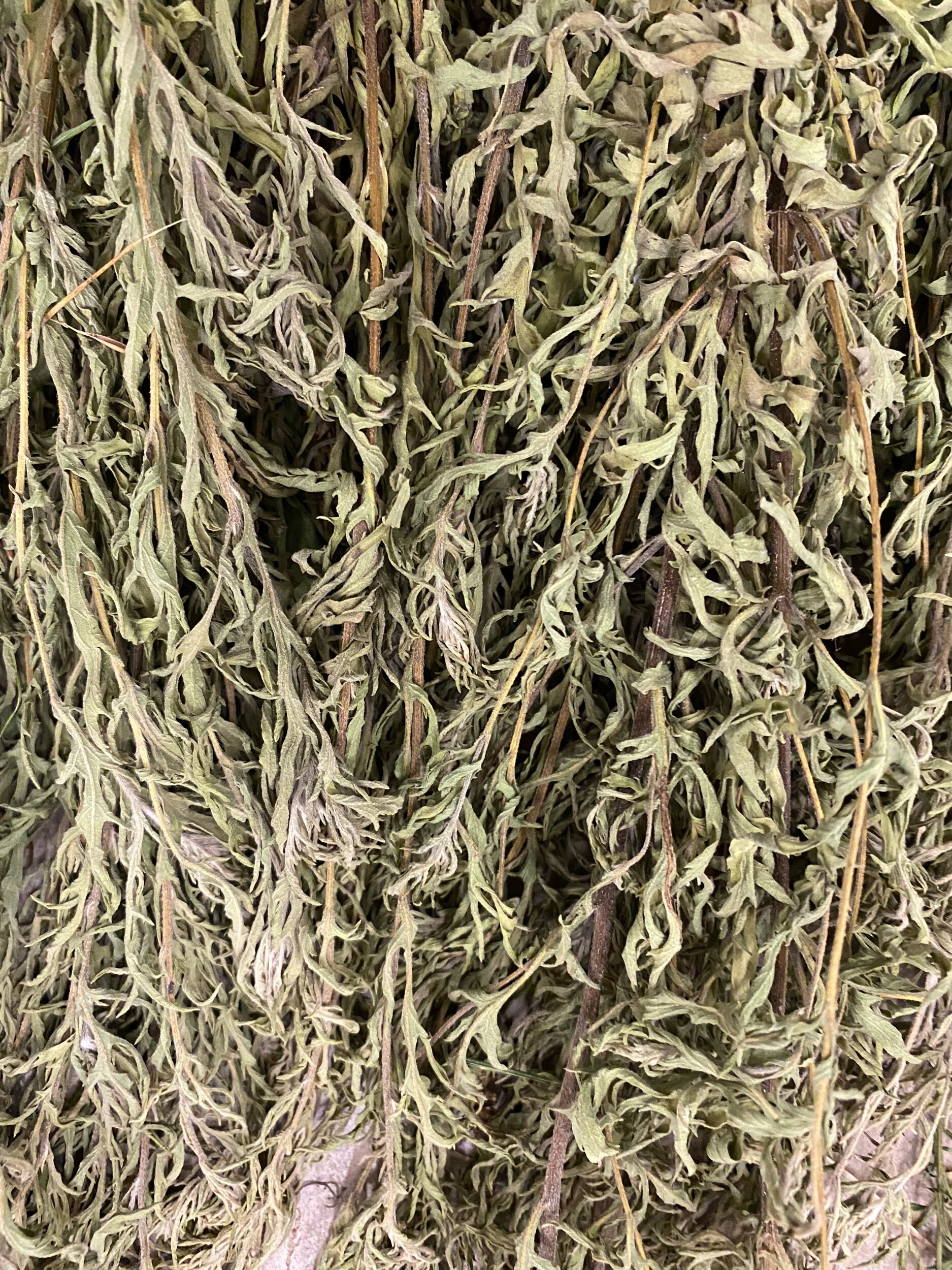


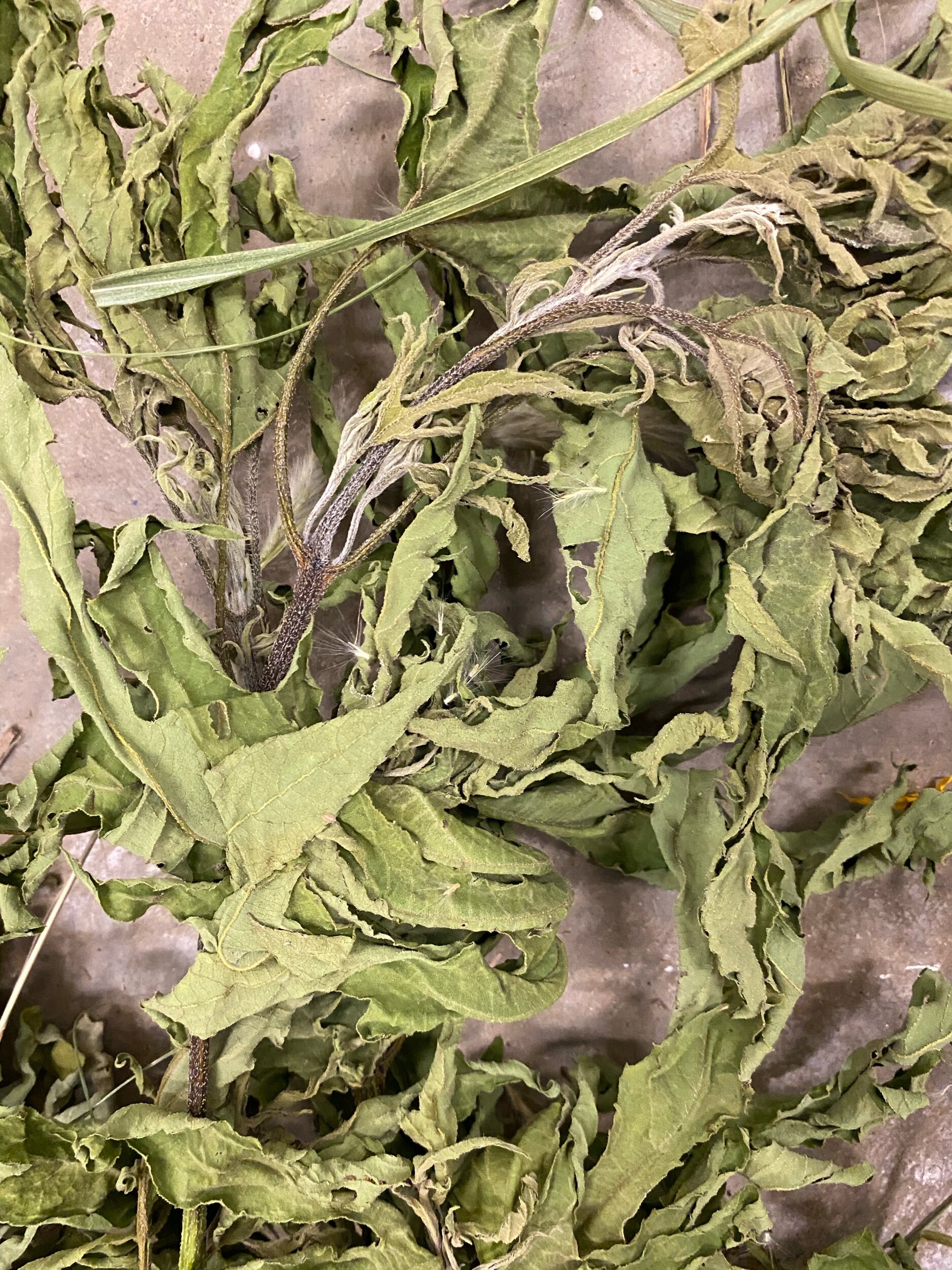

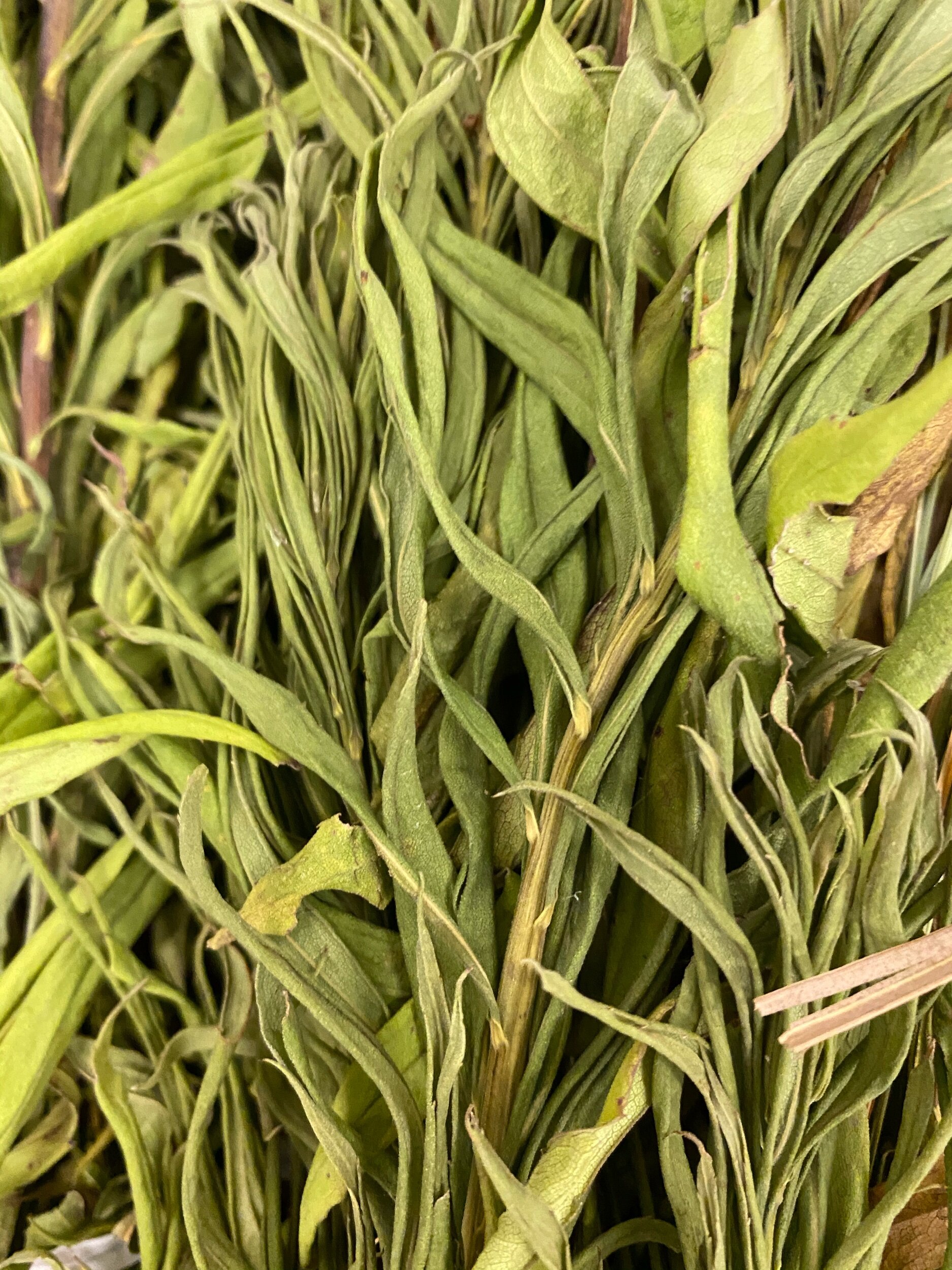


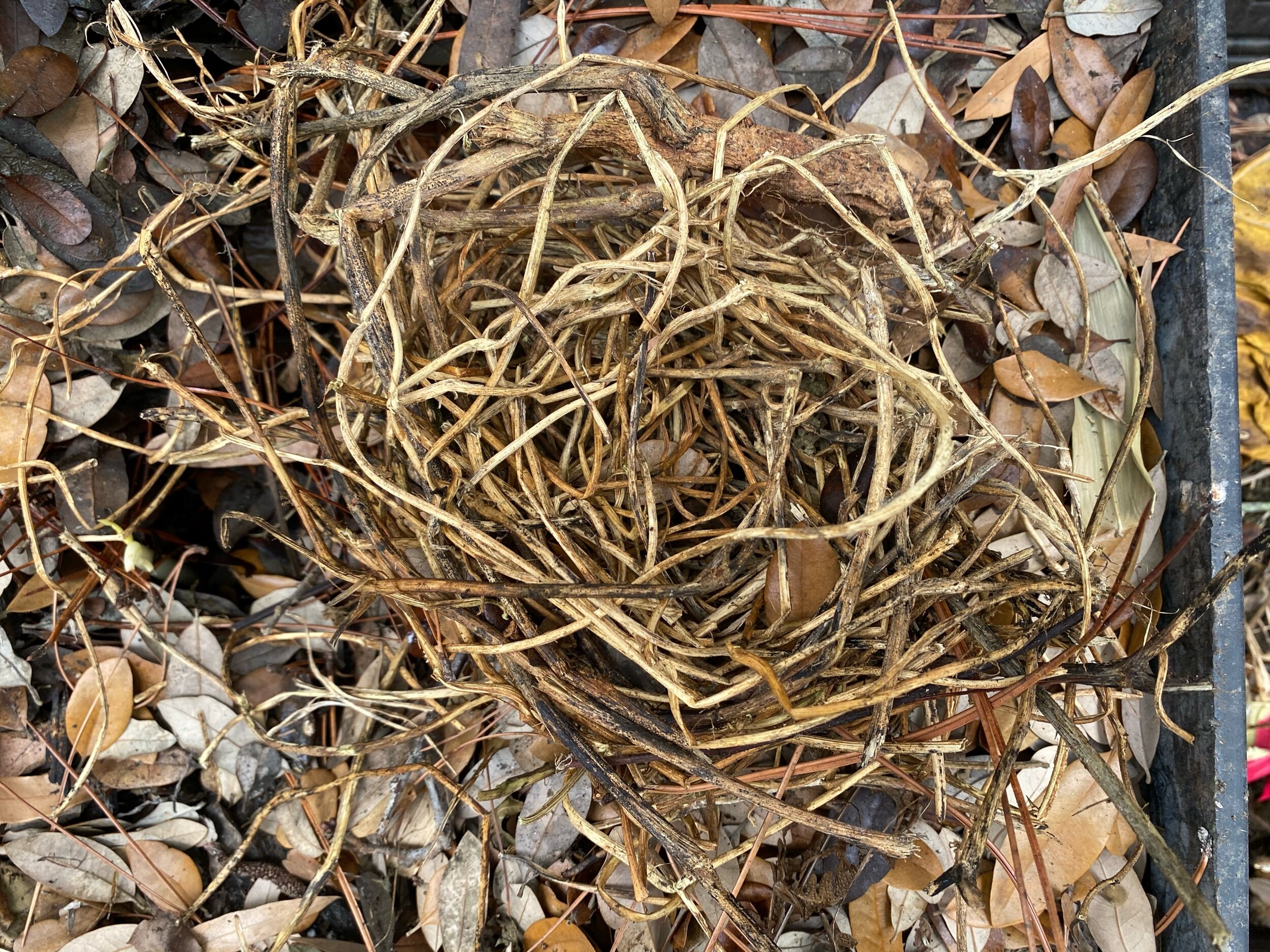
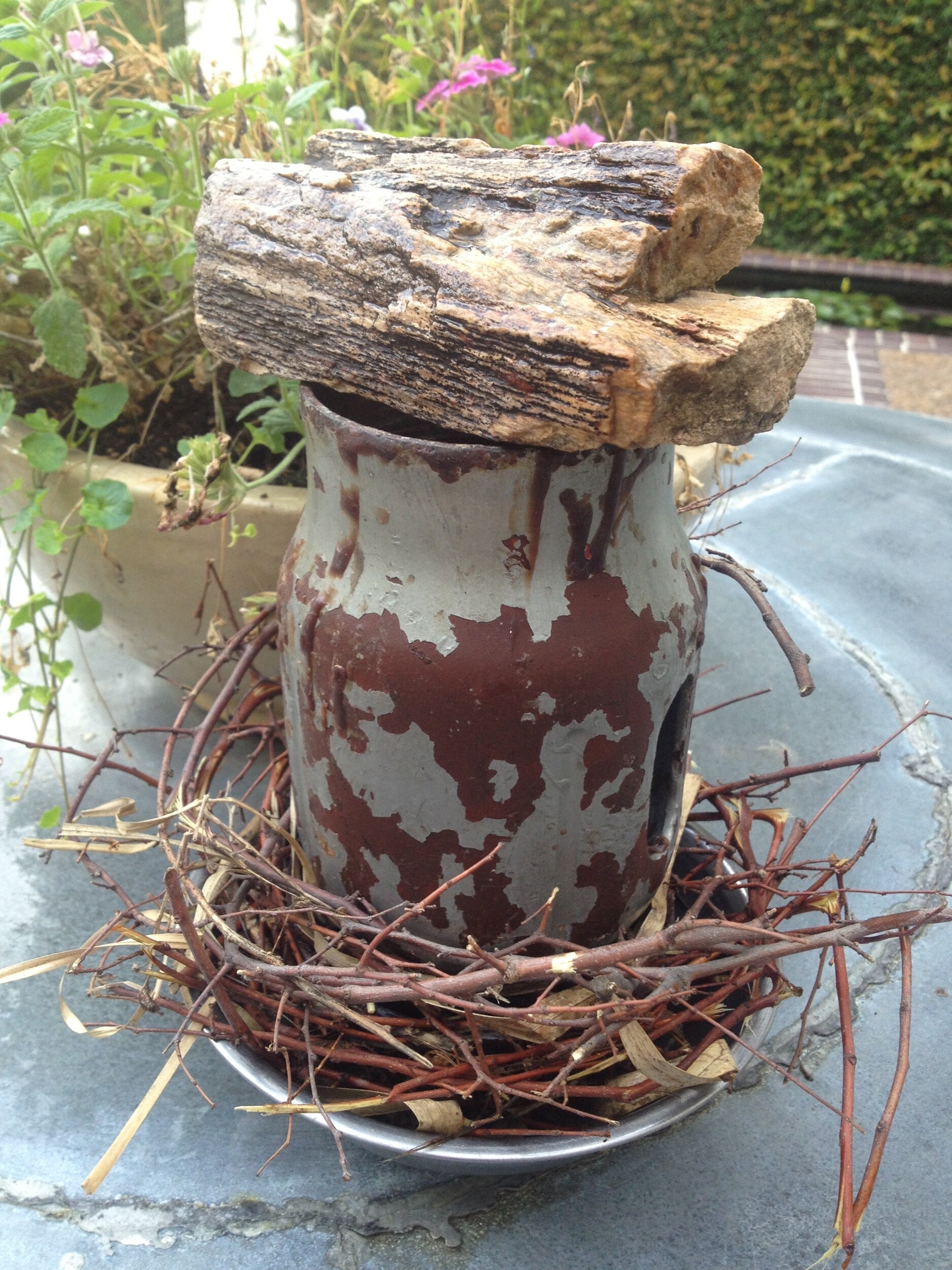
Shaping the dried organic matter.


Creating a system to get bronze into the sculpture.
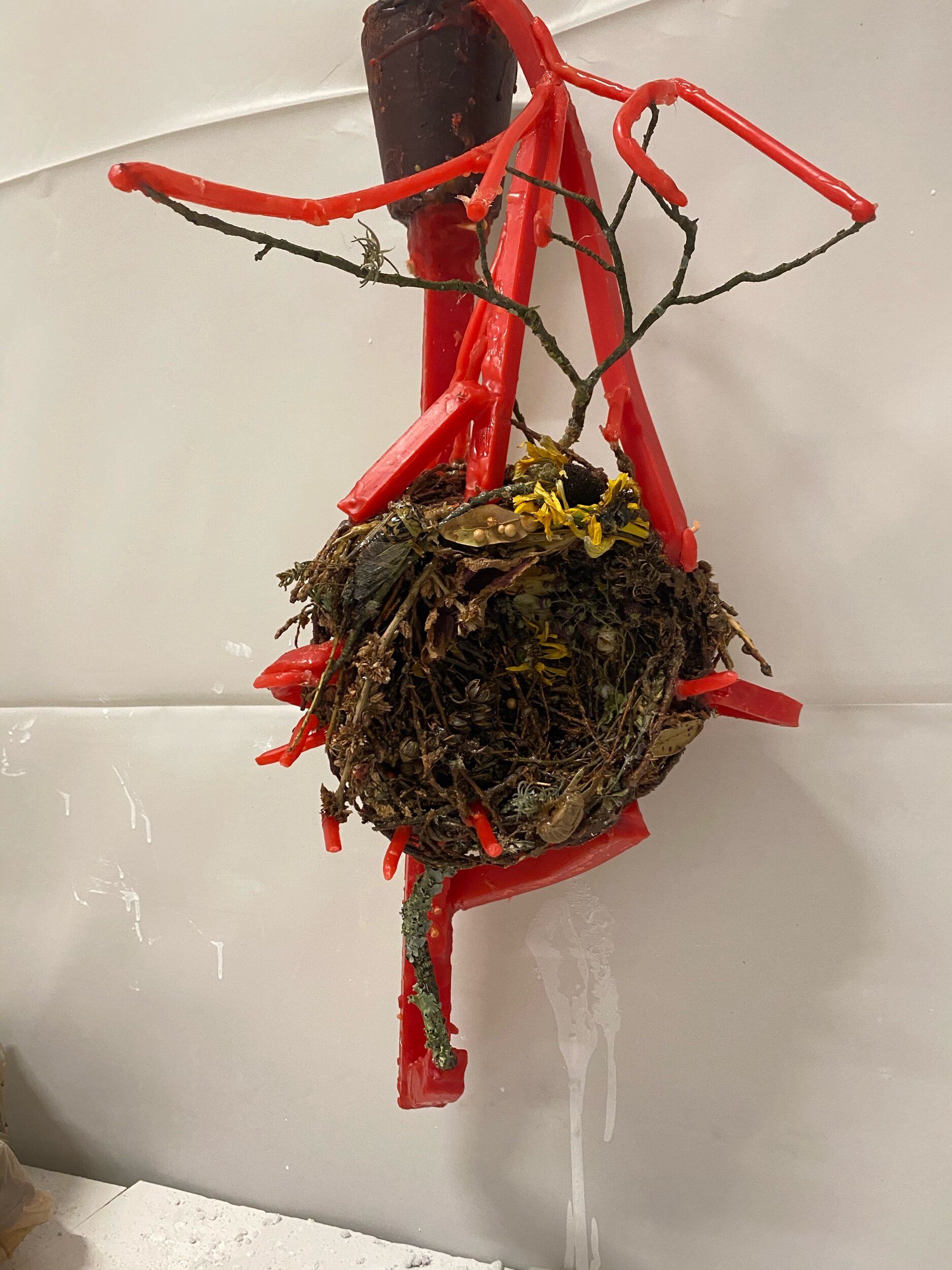
The best with the wax sorue system.
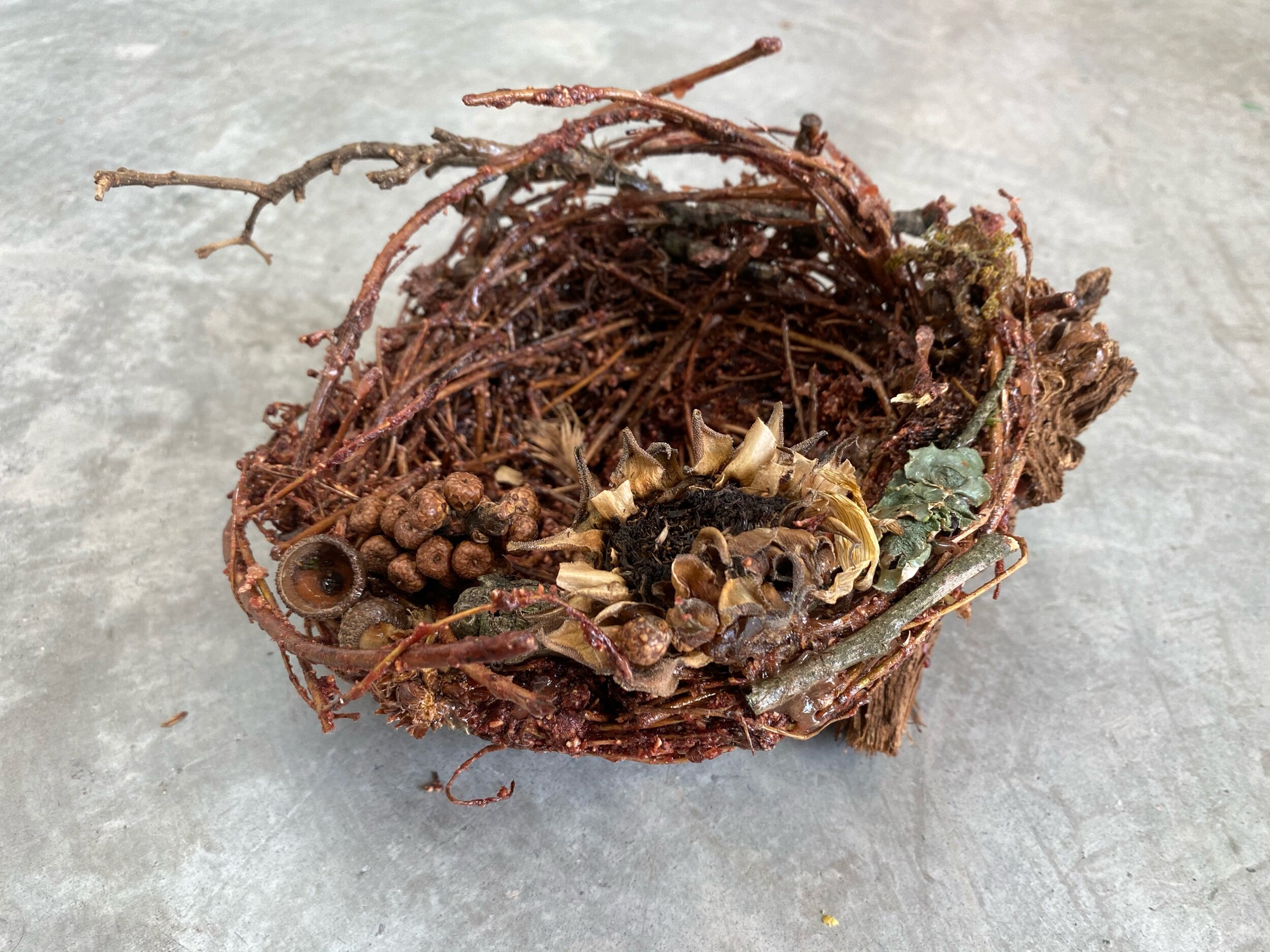

The sprue system after the first dip in slurry.
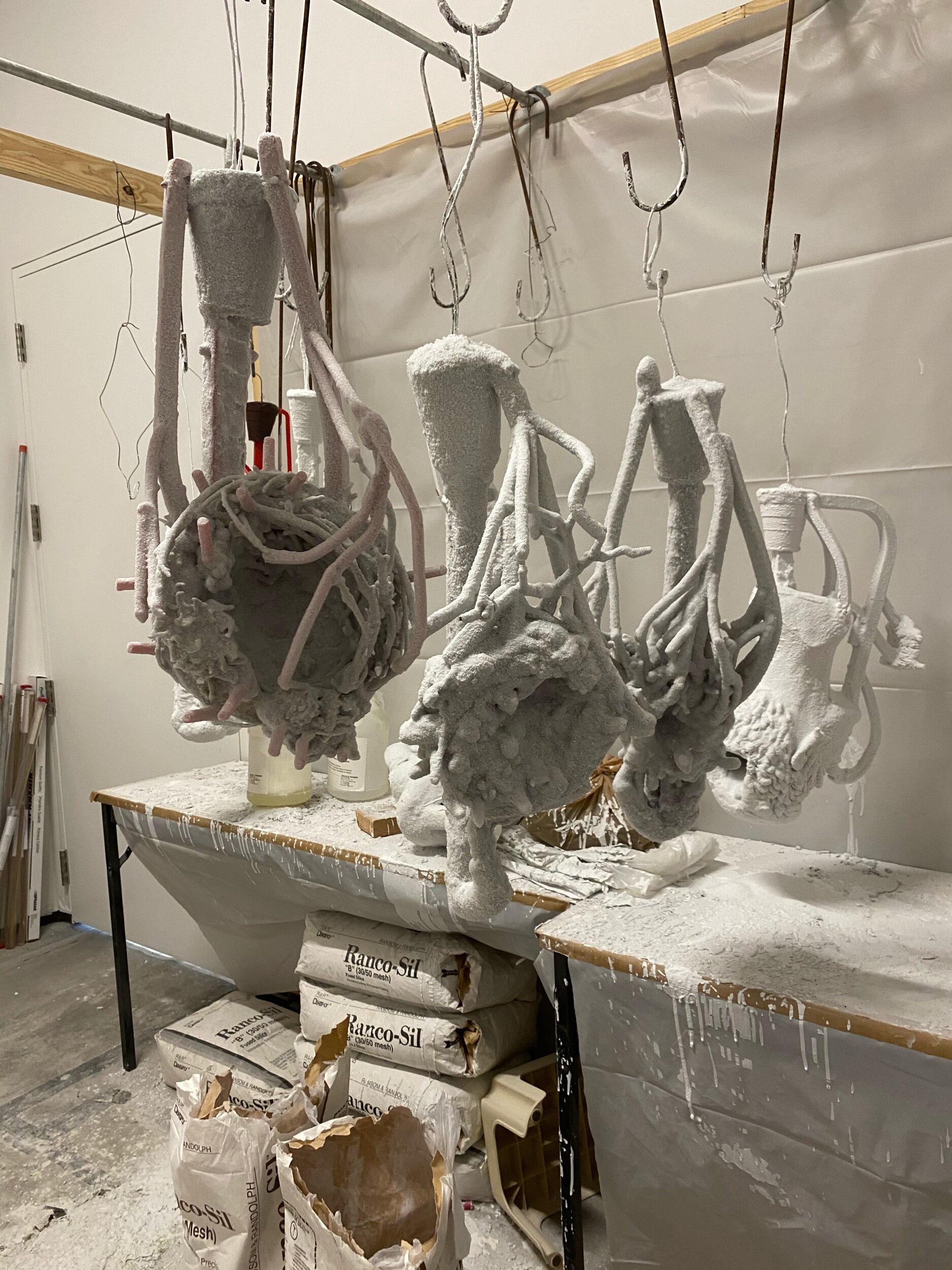
All three pieces after several dips.
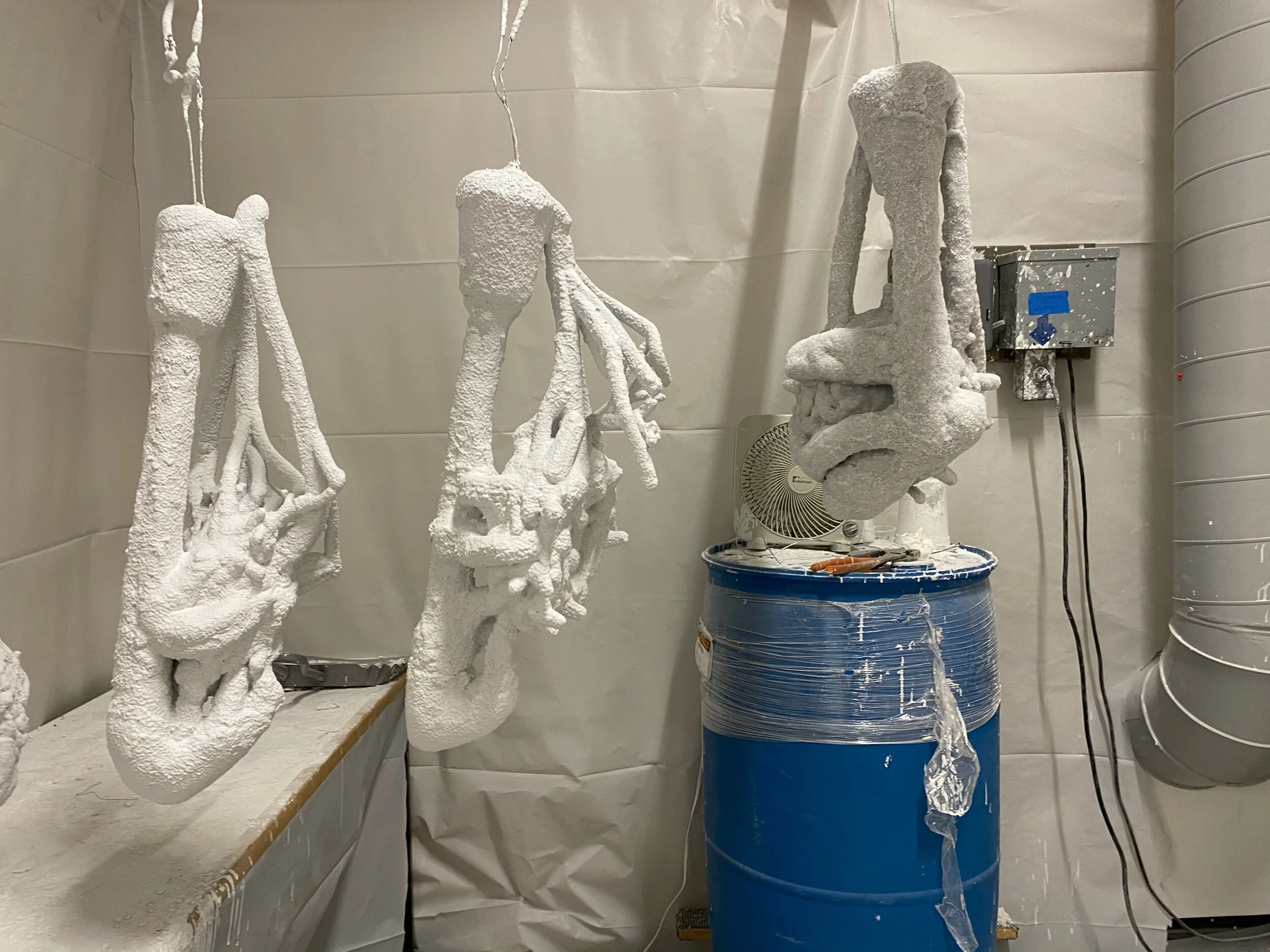
Drying after the last dip to build the shell.
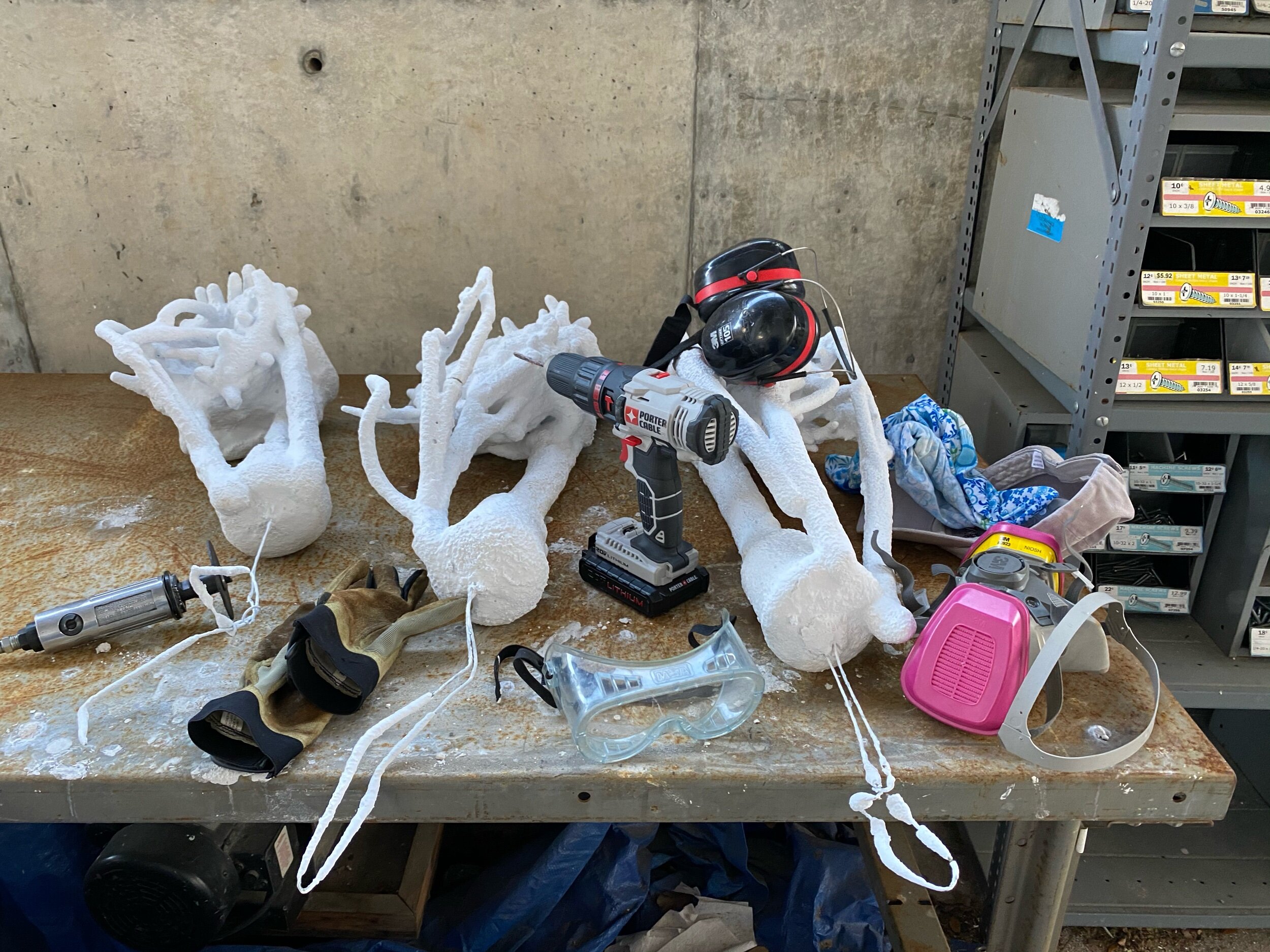
My tools to cut off the top of the cup and blind vents. The wax will drain out if the tuop of the cup. I also drill holes to keep the shell from cracking as the wax expands in the furnace.

After cutting the cup and blind vents.

The pieces at legacy as Victor is breaking off the shells.

The three nests and some small bronze casting to use for studio visit gifts.
Nash Baker is my art photgrapher, Nash lost his photography studio to a fire studio during COVID. I will wait to have these pieces photographed when he is back in operation.
It needs a light sanding, a patina on the bronze and the concrete.
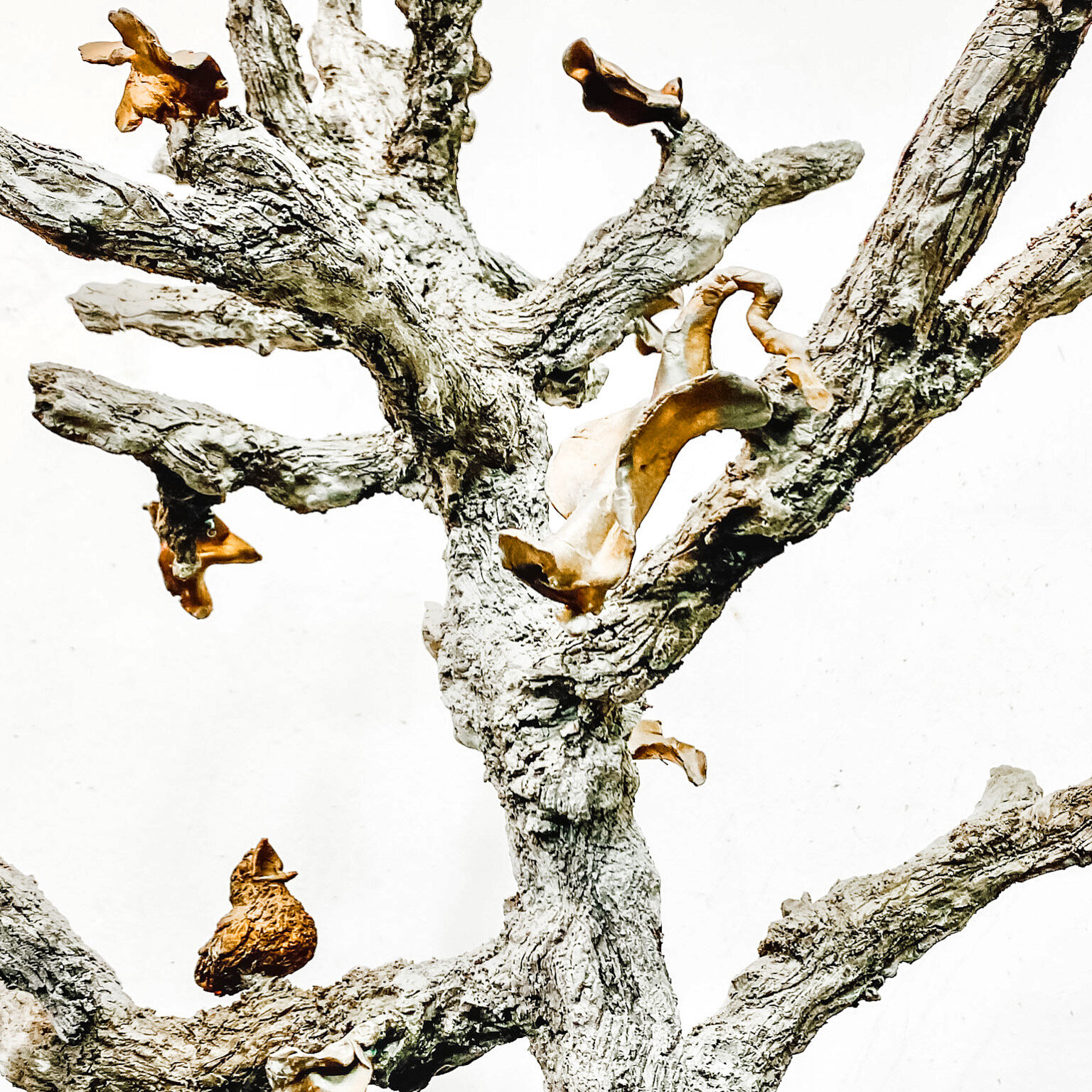
My daughter special requested this piece. She asked if I could make her a sapling. My response was I could try, but the pencil size steel limits how thin I can make the tree limbs. Long story short, the sapling grew old fast. After the first coat the sapling limbs we're no longer sapling thin.

Covered in lath

Keeping an eye on my mix

The first coat - the bronze leaves are covered in green plastic to protect them.

First, I paint on the bonding liquid.

The piece is now ready for coat number 2.

Coat number 2 ✅

Here is the image edited super light in order to show the texture.

More details

Detail of upper branches

A little more concrete need under the bird.

Detail of trunk

The lower trunk and base.
The abundance of knots is evidence that this tree is the host of many insects and good bacteria. Bees and other insects use trees for nesting and receive antiviral properties from the fungus and bacteria that grow on the tree.

Since last November I have been dropping hints to Houston Chronicle writer Molly Glentzer to write a native bee article. Earlier this week she called to talk about native bees. Some of the information I talk about when I talk about bees is alarming. She asked if I knew a locacal native bee athaurity, I did not. She said she could find one.
Here article came out today. Sadly she did not mention my bee art activism but the native bee specialist confirmed everything I have been saying. And yes It is alarming. Knowledge is power. - plant native non hybrid plants, blue, purple, yellow and white primarily. Starting the conversation with art activism.
her awesome article is below.
https://www.houstonchronicle.com/life/gardening/article/Your-Houston-garden-needs-native-bees-15287310.php

It turns out I did the first finish coat in white concrete. I have decided to put another coat on in the great concrete.

Here you can see the difference between the white and the grey Portland concrete.

I also have a repair to make on a back leg.

Repair made

The new underside top coat with personalization note for The newly weds.
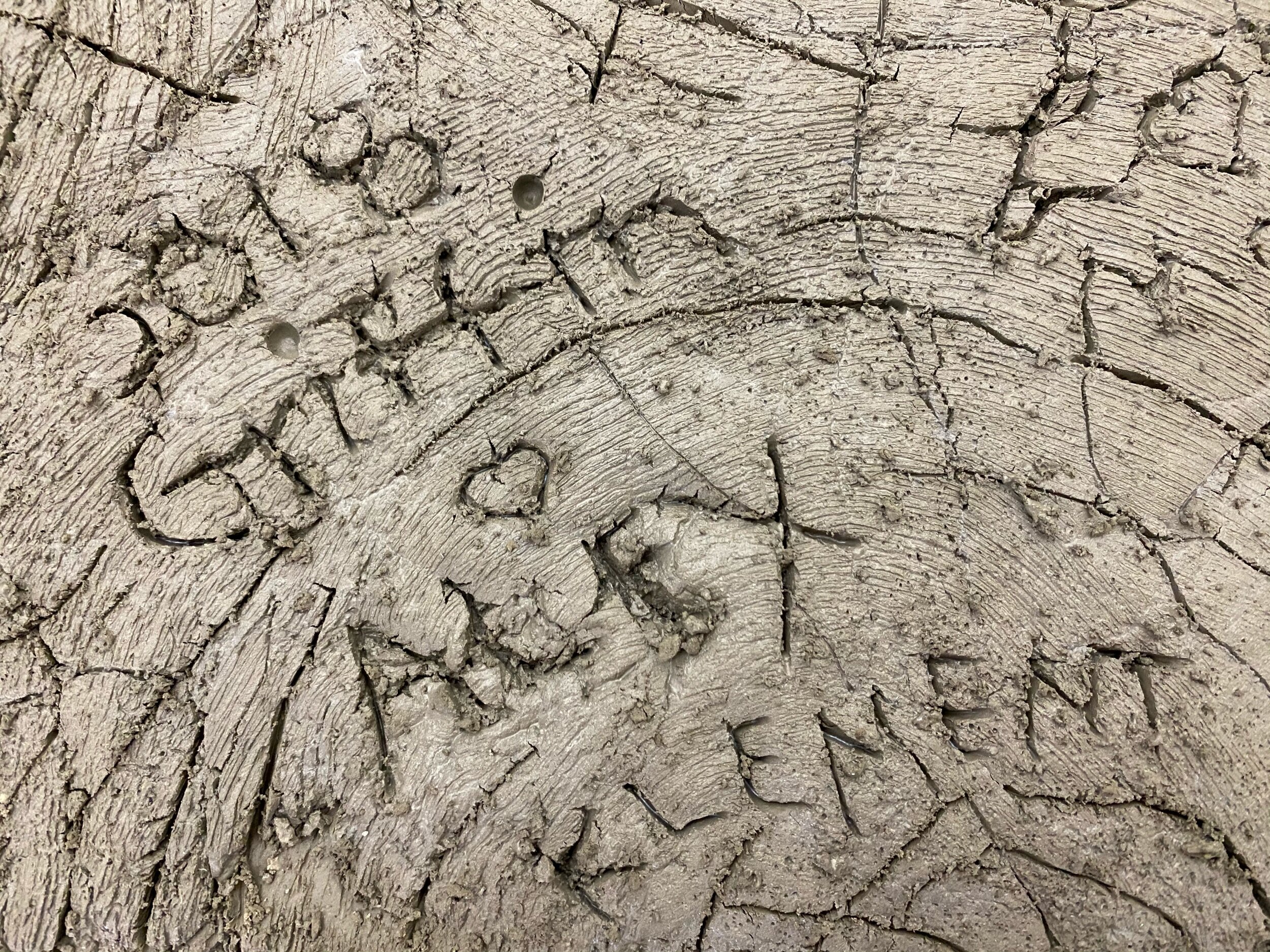
The year the married 1/3/2018 and there names griffin Joseph Klement and Alexandra Marie Groome Klement
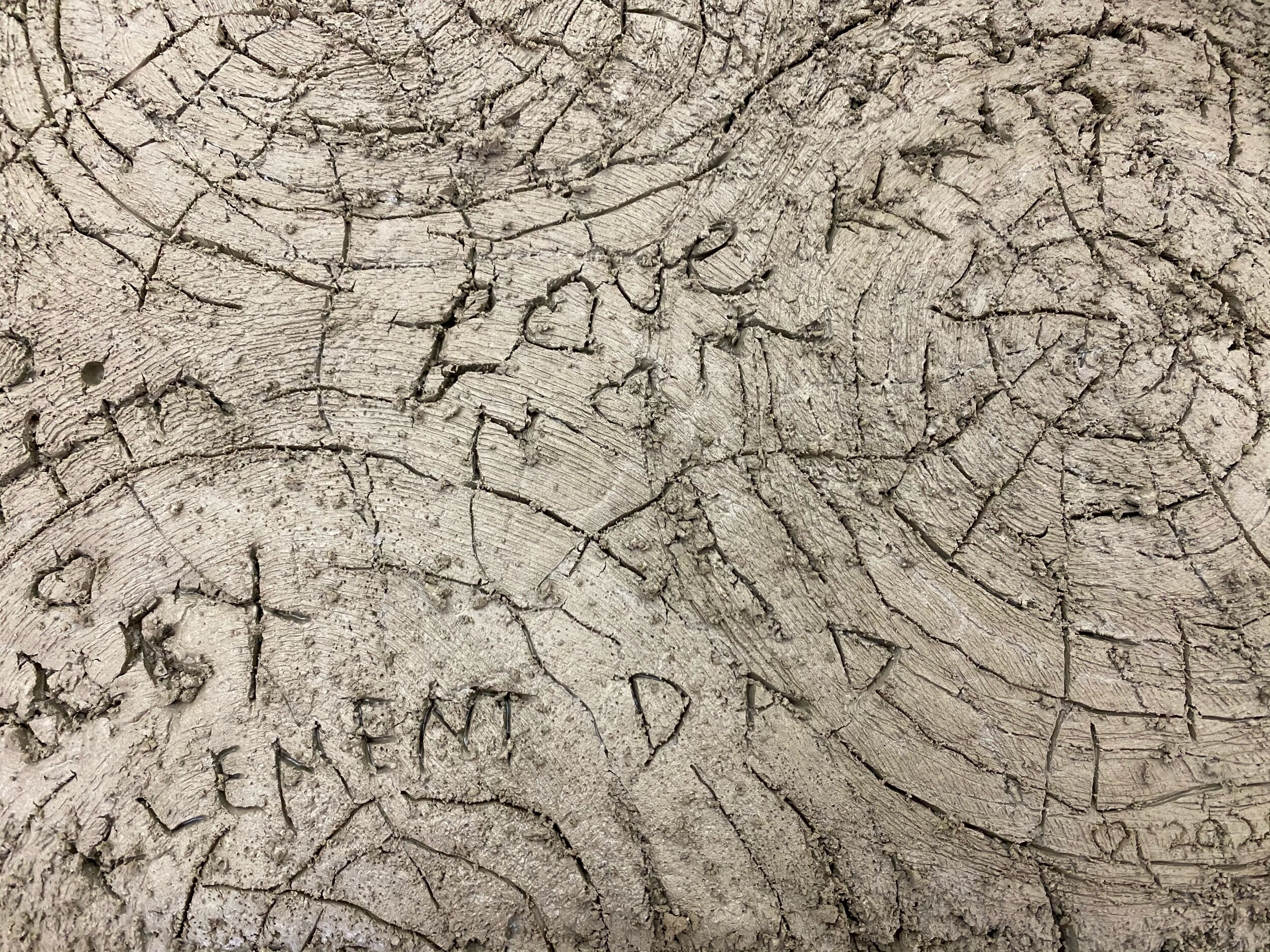
With love from me- Mom -cindee Travis Klement and Curtis Joseph Klement
The inspiration is from my grandparents yearbook page so I added my maiden name to the left of my name. I put the Klement last name between both sets of names.
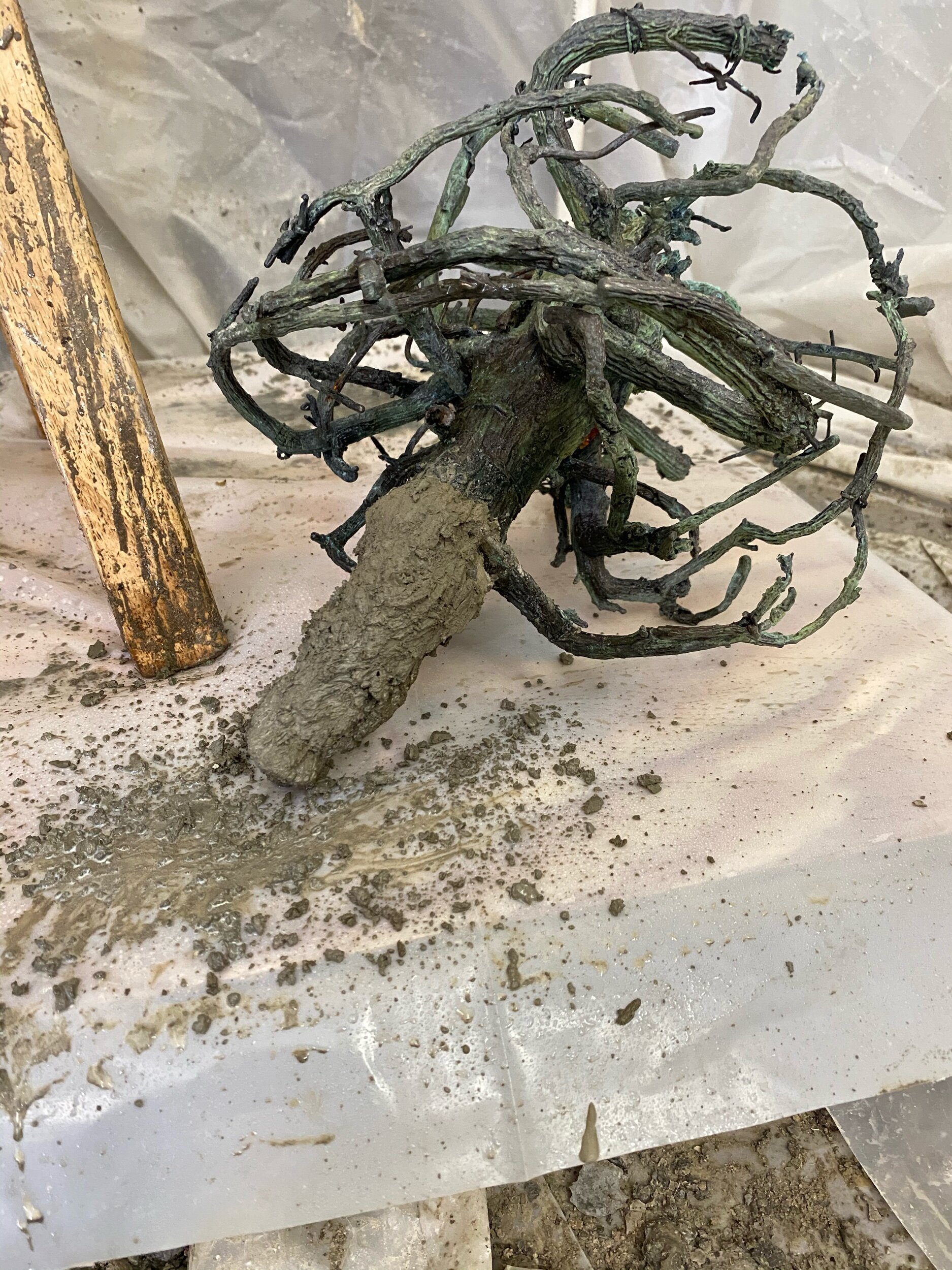
Adding a stump to this root. I am on the fence on this.
In a moment of global uncertainty, I ask myself, what materials would I use to leave a message for future civilizations? As I think of artists who painted caves, of muralists from the past, of artifacts from ancient civilizations, I am curious about how we leave a mark. My answer is tied to the natural world: much of my previous work has been about conservation issues, looking specifically at bees, at waterways, at recovery from Hurricane Harvey, at bison and now, at grass. And so, if I were to write a message to the future, I would use grass to write it, and bison to carry the message.
Endangered Knowledge: The Soul of Humus
For this year's Sculpture Month, I propose a site-specific sculpture of a bison, made from a welded steel armature, a work of land art covered in topsoil and dried native grasses. This is part of a comprehensive installation that I am currently developing, which considers the role of the American bison within Houston's specific soil ecological history. The work is titled Endangered Knowledge: The Soul of Humus.
It is inspired by the words of M. Thomashow, who writes, "Record natural history to the collective memory so that it is no longer endangered knowledge." For several years, I have been researching grass-fed food production, attending soil conferences, and visiting regenerative ranches. Research in these fields show how to fight desertification and reverse climate change through regenerative agriculture practices. Interestingly, this natural history of living soil, how it evolved in the Houston Coastal Prairie, and its essential part within microbial communities in human health, is not common knowledge.
Description of Work
In the hide of a sculpture, I tell the narrative of soil health. My sculpture will record this endangered natural history through the dense coat of the powerful humus-built bison, that will be dripping in the armor of locally sourced dried native grasses and sedges, seeds, and pods. The male bison will be supported by a welded steel armature, covered in a stainless-steel lath. The bison's skin, made from these dried grasses, will be attached to the lath with a Houston mud composite. I propose the 11' long bison be exhibited in the center of a large grain silo, the bison in an actively grazing stance, head down in plow position, his hump rising robust and bushy out of his heavy forequarters to 6.5' tall. Lighted from inside the grain silo funnel, viewers can approach the bison and intimately inspect the diversity of the native plants implanted in its pelt.
Ecological History
Historically B. bison functioned as the first farm equipment. The grass seeds clinging to their burly coats were carried across the plains as they migrated north to south and back between seasons, like tractors up and down fields. Herds of tractors not green, but a rich brown harvested the plains with their appetites, each bite stimulating new root growth. The old roots withered into cavities that served as dwellings for a variety of keystone species, and became underground cisterns collecting floodwaters for drier seasons. Their coats dropped kernels and cuttings as the winds ruffled their beards and chaps, and when they took dirt baths in buffalo wallows dug with their horns. Massive roaming compostors, a single bison cow daily dumping 40 lbs. of fresh manure onto these seeds and drilling them into the earth with their spade-like hooves, sprinkling them with the perfect prescription of nitrogen, phosphorus, and potassium-rich urine and then moving in a predator safe tight herd on to the next buffet. With time the newly sowed fields sprouted new growth of blades, stems, and leaves of countless shapes, sizes, and heights. This diversity of leaves fit like puzzle pieces into dense living solar blankets, harnessing carbon from the air and returning it as sugars to feed the dynamic root microbiomes below the earth’s skin. The complicated relationship between the soil microbiome and the human intestinal microbiome is one of the most dynamic topics in biomedical research. Flocks of birds mutualistically
living off the pests harbored on the bison followed the herds, drinking from and bathing in rainwaters that collected in the bison wallows, building their nests from clumps of bison fur. Recent studies show the fur provides a health benefit to unborn chicks. Bird and butterfly habitats were abundant when the bison roamed.
Relevance
Global warming, food security, drought/flooding, wildlife habitats, economic instability, and health – these problems are not new to humankind. The archeology of ancient civilizations has recorded connections between the longevity of civilizations and the health of their soil. The United Nations reported in 2014 that the world's topsoil would only last 60 more growing seasons. Soil scientists around the globe agree that solutions to these issues are rooted in our treatment of soil—the skin that covers our planet.
Message to the Future
The armor that protects the epidermis in the Gulf Coast prairie is grass. The animal whose population peaked at 30 million, is B. Bison. Combine native grasses with ruminants and the grasslands decompose into rich organic matter; for every 1% increase per acre of biological organic material, the soil can hold an additional 20,000 gallons of water. Restoring native prairie vegetation decreases water runoff and flooding, increasing soil absorption of water and slowing floodwaters on land. With extreme building practices and concrete hardscaping, reimagining the landscape of Houston's 600 square miles of real estate can make a significant impact on the region’s flooding. The prairie grasses' roots can extend from eight to fourteen feet deep: these roots sequester carbon like an upside-down rainforest. Changing our agricultural practices is an important step towards turning global warming right side up. Telling the dynamic story about these relationships between the grazing herds, the living soil, and finding ways to reimagine urban landscapes and agricultural practices in holistic and regenerative ways are the center of my current research and sculptural practice.
The impact of the bison on sustaining topsoil—and, therefore, life—need not be Endangered Knowledge. The role bison play within the prairie ecosystem—their ability to increase photosynthesis, reduce competition for water, and regenerate depleted, unsalvageable, lifeless prairies back to productive and bountiful, nutrient-producing land and wildlife habitats—needs to be carved into our modern systems. Recording this Endangered Knowledge into the consciousness of humankind will stimulate grassroots efforts and stop the cultivation of soil depletion and return the natural process to the treatment of the skin of our planet. A Parietal artist in 2020, I will use grass to record the Soul of Humus so that it will no longer be Endangered Knowledge.
Additional work
Soul of Humus will be the first piece in my Endangered Knowledge body of work. The complete body of work will eventually consist of the following sculptures: 4 pedestal-shaped sculptures of roots and soil, measuring approximately 12" X 12" X 36"; installations made from native grasses and their roots (size and number to be determined); 1-5 bronze castings of bison dung with their spade-shaped hoof prints, dung beetles, and mushrooms. I am also currently in conversation with a bison rancher to secure a bison heart to float in a glass case of formaldehyde: the bison, the largest mammal of the western continent, is the heart of our soil diversity, it is the western symbol of a healthy planet. The health and longevity of civilization, as we know it, is dependent on finding ways to mimic the natural process stampeded into the bayous of Houston. In this sculptural series, I look closely at the components of this process and the environmental interrelationships unique to the Houston area and world health.
Footnote-
Bison vs Buffalo which name is correct? The common name Buffalo has been widely used, since early settlers were naming them as their European and Asian counterparts. The correct name of the last American surviving bison is B. Bison.
Further Reading and information –
- Allan Savory on how to fight desertification and reverse climate change
- Soil as Carbon Storehouse: New Weapon in Climate Fight? - Yale E360
- A Prehistory of Houston and Southeast Texas,– D. Worrall, coming fall 2020
- Can Livestock Grazing Stop Desertification?
https://www.scientificamerican.com/article/can-livestock-grazing-stop-desertification/
- Dirt: The Erosion of Civilizations, by David R. Montgomery
- Soil Biology and Land Management https://www.nrcs.usda.gov/Internet/FSE_DOCUMENTS/nrcs142p2_052489.pdf
- Wildlife that Depend on Bison
Sample Work and Visual Support Materials for Proposed Sculpture
Two small sculptures that are made with the same structure, process, and made with native plants-
The bison will be furrier than these small birds are and would be dripping in a thick coat of textured dried grasses.

Hay Day Peace Pigeon 2016
15” X 12” X 8”
welded steel armature, plaster and hay

Feathery Finery Peace Pigeon 2016
12” X 12” X 6”
steel armature, steel lath, plaster and plants
Three large sculptures that are made with the same armature and process, but I have used metal instead of dried plant cuttings on the surface for texture.

Broken 2018
40” X 29” X 55”
Welded steel armature, stainless steel lath, concrete, wire cloths and wire

Sonata in 4D 2018
6’6” X 5’5” X 5’
steel welded armature, stainless steel lath, plaster, wire cloths and wire

Bringing Home the Bacon 2019
66” X 42” 60”
welded steel armature, stainless steel lath, hydro stoner, wire cloths and wire
There are many textures of native grasses at the Katy Prairie Conservancy and Buffalo Bayou.
If you accept my proposal, I plan on asking the Katy Prairie Conservancy and the Buffalo Bayou Partnership to allow me to source my grasses and plants from their properties.

Sample of one of the many amazing textures on the various grasses and plants in the coastal prairies.

This shows the movement I am visualizing on the coat of the Bison
Below are Some of the source images I will use while sculpting the bison.
most of these I took doing research at Roam Ranch this summer, fall and winter.

This shows the position of the head I am looking for, it is grazing but you can see the face. This is a cow (female) My piece will be a burly big old male.

This is a large bull but it is not very old. My sculpture will be an old male that will have scrapped up and chipped horns from fighting and digging wallows and a massive thick (and dripping with dried grasses) big beard and chaps. This side view is pretty close to what I have in my head. I might have his head turned slightly to one side. That could be determined by which side of the building the silo would be on. The face will be more interesting and textured than the back side of the bison will be. My sculpture would be grazing on taller grasses. I would also raise his head for more eye contact

This is a good image of a bull’s face. Not my photo.

another view- not my image
It was never my intent to become an environmental activist – I am beginning to wonder if that is what I am. Since the below email I have had one meeting with Sally Alcorn and her assistant Hannah Cobb. They are on board with my thoughts and want to help. We decided the first step is to look at the citi’s present landscape ordinance, and then Coronavirus 19 hit Houston.
I guess even in a pandemic certain things have to continue, such as city budget planning. I received an Instagram message from Sally April 27th at about 11:00 pm regarding a video of the City Council meeting and the City Parks budget. I will make another blog post summing up the results of that meeting. Maybe this pandemic will open some doors that normally would not budge.
TO: Sally Alcorn salliealcorn@comcast.net
Dec 27, 2019, 10:14 AM
RE: Houston’s impact on bees.
Sally,
It was great to run into you at the mother-daughter Christmas party. I appreciate your interest in positioning Houston to become the leading city in the U.S., addressing the native bee environmental issue. You have a lot on your plate with your new elected position, so I thought I would recap a few of the important topics we discussed.
Scientists predict that without pollinators, human life can only continue for four years. In 2017, the U.S. Fish and Wildlife Service listed the Rusty Patch Bumble Bee on the endangered species list. The campaign to list a species as endangered is lengthy and complicated. With this system, it is difficult to gauge how many species are actually endangered.
Bees are responsible for pollinating 75% of the world's flowering plants; they are crucial for the production of most fruits, nuts, and berries – our agriculture depends on pollination by bees.
Rural areas are highly impacted by the unanticipated consequences of our industrial agriculture’s dependence on chemicals that weaken bee’s immune systems. Urban bee populations can be more diverse than in rural areas. Researchers are finding in cities such as Chicago, Berlin, Berkley, and Melbourne that have reimagined their parks, neighborhoods, city centers, vacant lots, street medians, and rooftops planted with native flowers, grasses, and fruit, and vegetables support healthy, vibrant wild native bee populations.
In the US, there are four thousand native bee species. They pollinate over three hundred times more effectively than honey bees. For example, A single female Leafcutter Bee visits 100,000 plus blossoms per day whereas a honey bee visits 50-1000.
Unlike the honey bee, Native bees do not swarm, are not aggressive. Native bees are perfect for urban population centers.
Houston covers 600 square miles of land and has one of the longest growing seasons in the U.S. As it continues to sprawl across Texas, its gardens must increasingly become a refuge for native plants and animals. With 2.3 million people living in the most vital economic, cultural center of the south, we can become the most critical urban native bee habitat in the United States.
I have spent the last year and a half studying the bee situation as it pertains to my art and my interest in regenerative agriculture. I am determined to take this knowledge and save the bee in urban settings.
With Houston's land size, population, and location in the Sunbelt like it or not-we are impacting the bee population.
I realize we will have to start with baby steps. Let's put our creative minds together, save the native bees, and build a better energy capital. This is a great opportunity for our new city council.
I am very flexible are weekdays or weekends better for you to get together?
Best,
Cindee
P.S.
If Cuba can create urban gardens to feed it’s poor can you imagine what we can do.

Bolt, name and ashes of R.I. Travis.

I used the white concrete to create motion in the old wood.

I went a little crazy
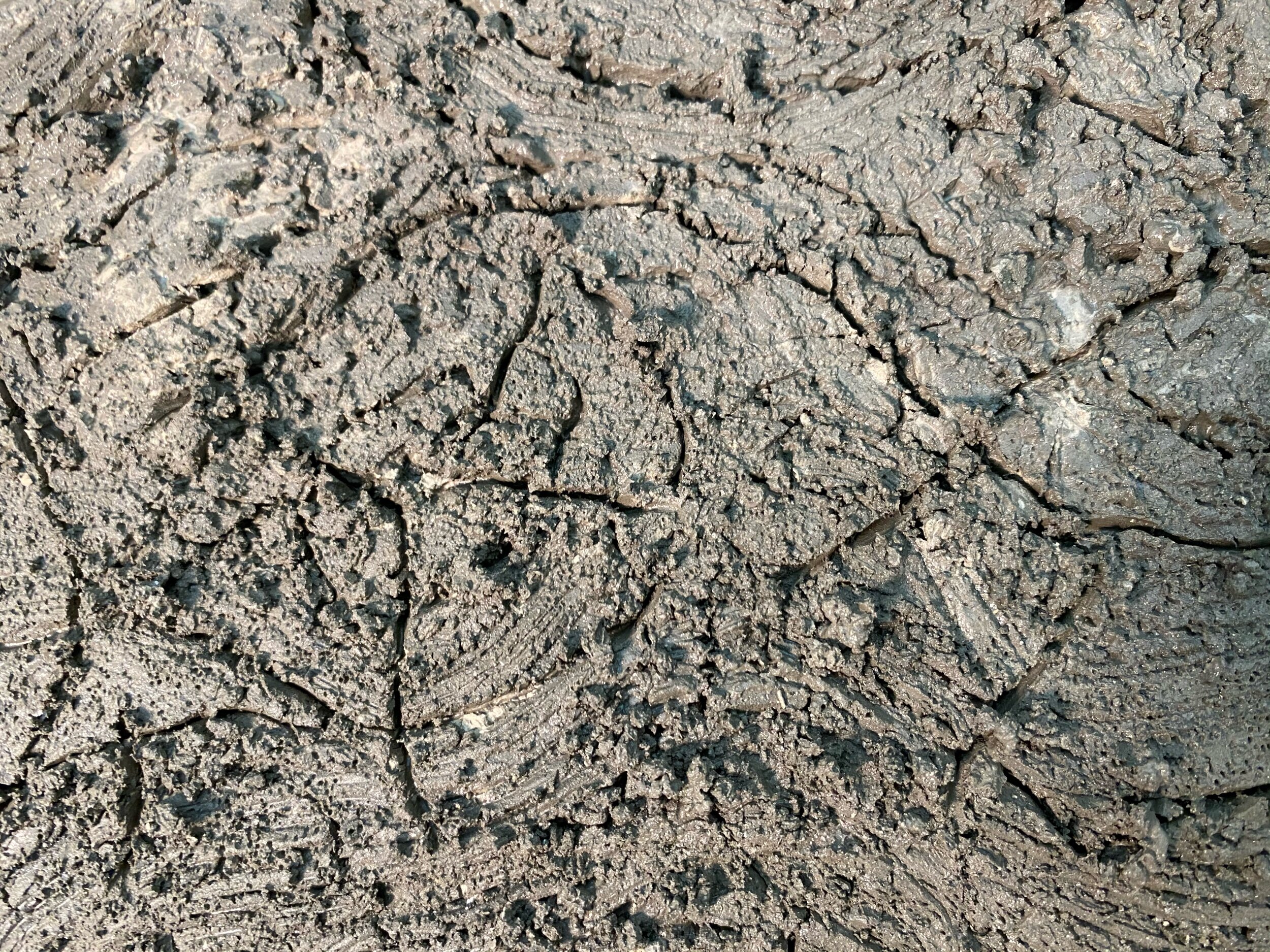
A sweet knot with some severe old wood cracks.


I gave the birds a knot to perch on.

Another view of Bob Pa’s moment in the bench.

Wormholes and knots
Below is a photo journal of the process.

Mixing the wet part of the concrete mix.
Mixing concrete is very similar to baking, you have to measure every ingredient precisely and mix them in the correct order.

A sound concrete mixer is a must; hand-mixing concrete is just too physical. I love this machine. Behind the mixer you can see roots for future bronze pieces drying on the plant trellis

Fifteen minutes of mixing the dry ingredients.

While I wait for the dry ingredients to mix I paint a bonding agent onto the scratch coat.

A close up of the white bonding agent after application.
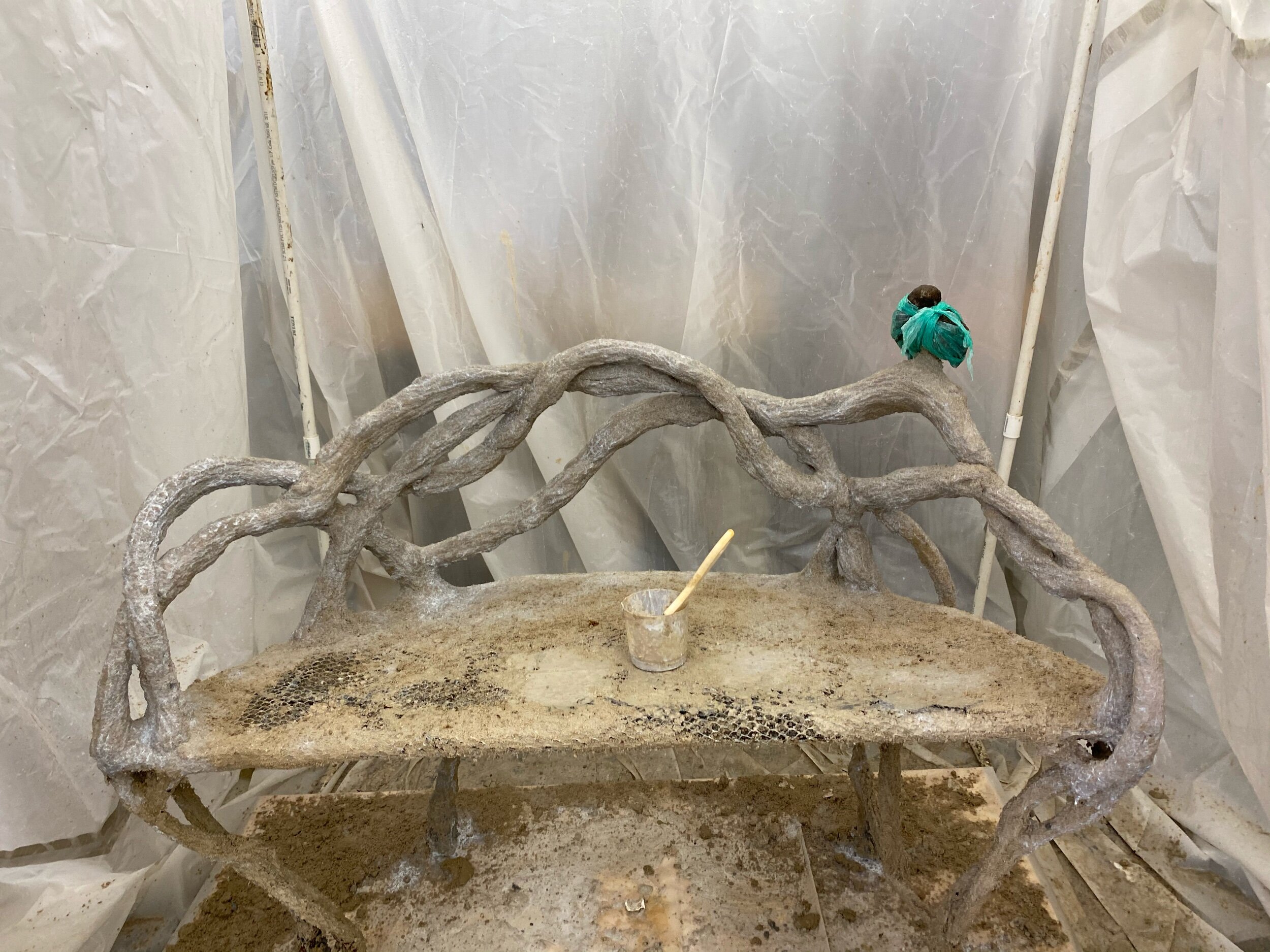
All branches are coated with the bonding agent and drying while I check on the cement mixer.

When you look closely you can see the fibers I put in the concrete last week. The fiberglass fibers help the new layers of concrete bind to the last coat.

Just like in baking, you pour just a little wet ingredients in the middle of the dry ingredients.

I clip a cardboard door to the mixer, to keep the dust down.

The mixer kicks up a lot of dust.
Even before ppe was a thing, I wore a respirator and a head covering when mixing cincrete. There is nothing like shampooing concrete dust out of your hair.

Here the mix is starting to stick together and make marble and golf size balls. Ut us about 1/2 way ready.
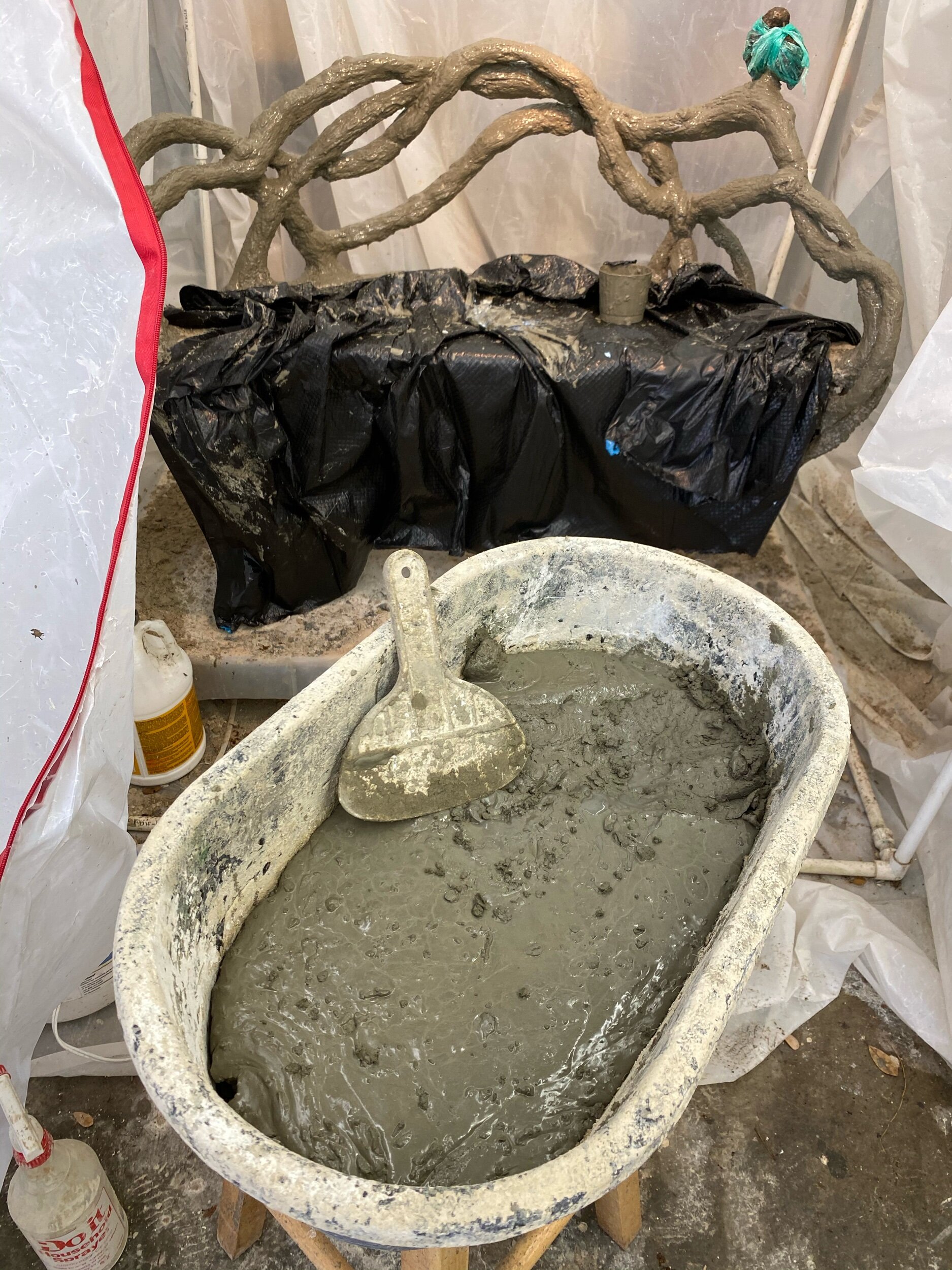
Ready to start applying the concrete to the branches.

First, I mix a little concrete with the white bonding agent and make a slurry. I paint the slurry mud into the branches to help the first coat stick. Then I wait for it to get tacky.

Another detail look. Some of the fibers from the prior coat are still sticking out. That is ok, when I am finished I will take a small torch Abd burn them off.
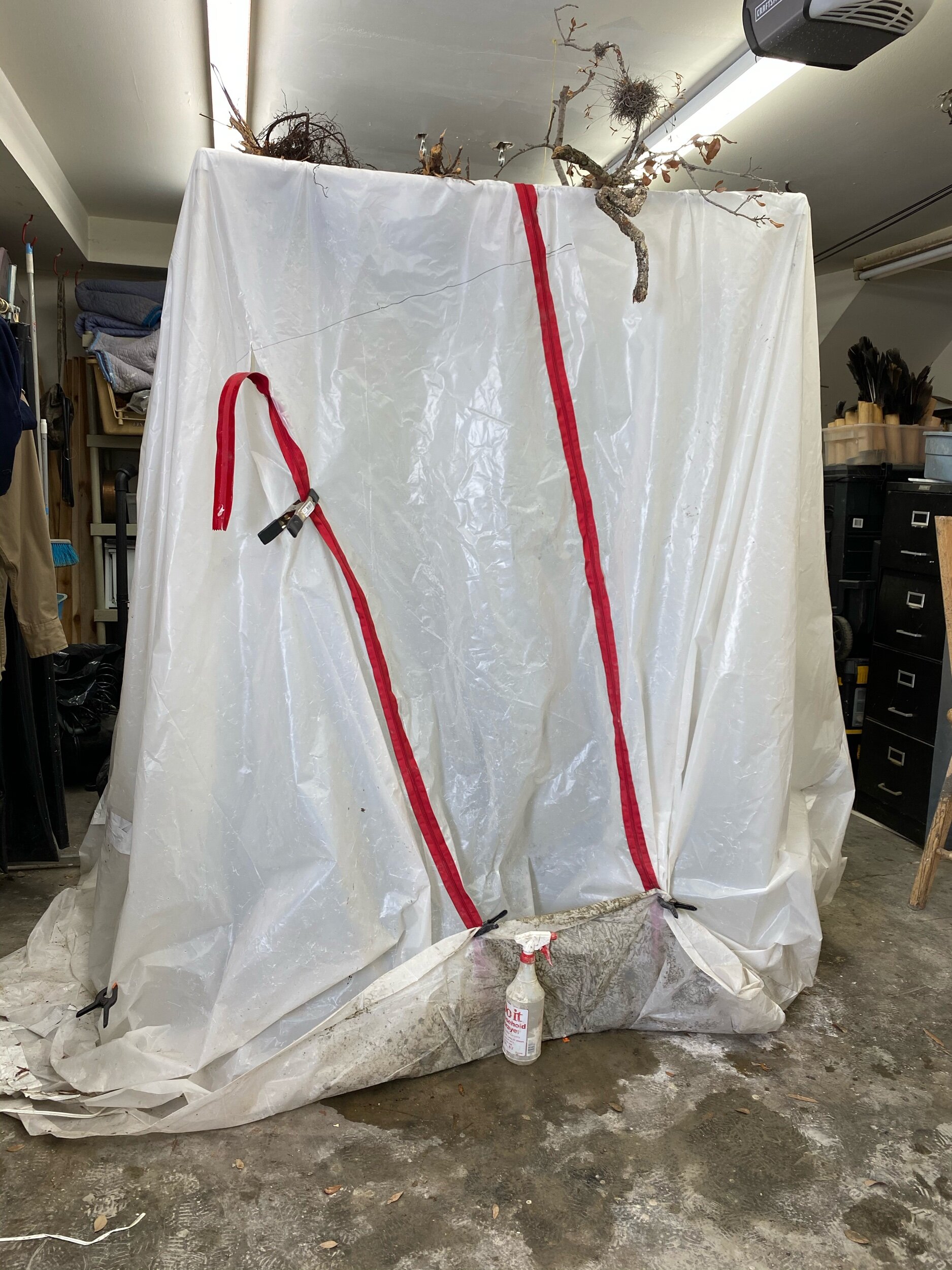
My hydrating tent is getting a bit caddy campus.
Five more days of hydrating and then I pour the cement for the seat.
Last Thursday while in Coronavirus 19 quarantine/social distancing I poured a top coat for the upper branches. I actually mixed all the ingredients over a year ago and then got caught up in making the pieces for my Hurricane Harvey Heroes exhibition 51.88” -Art of Resilience. The bucket of dry mix sat by the cement mixer untouched.

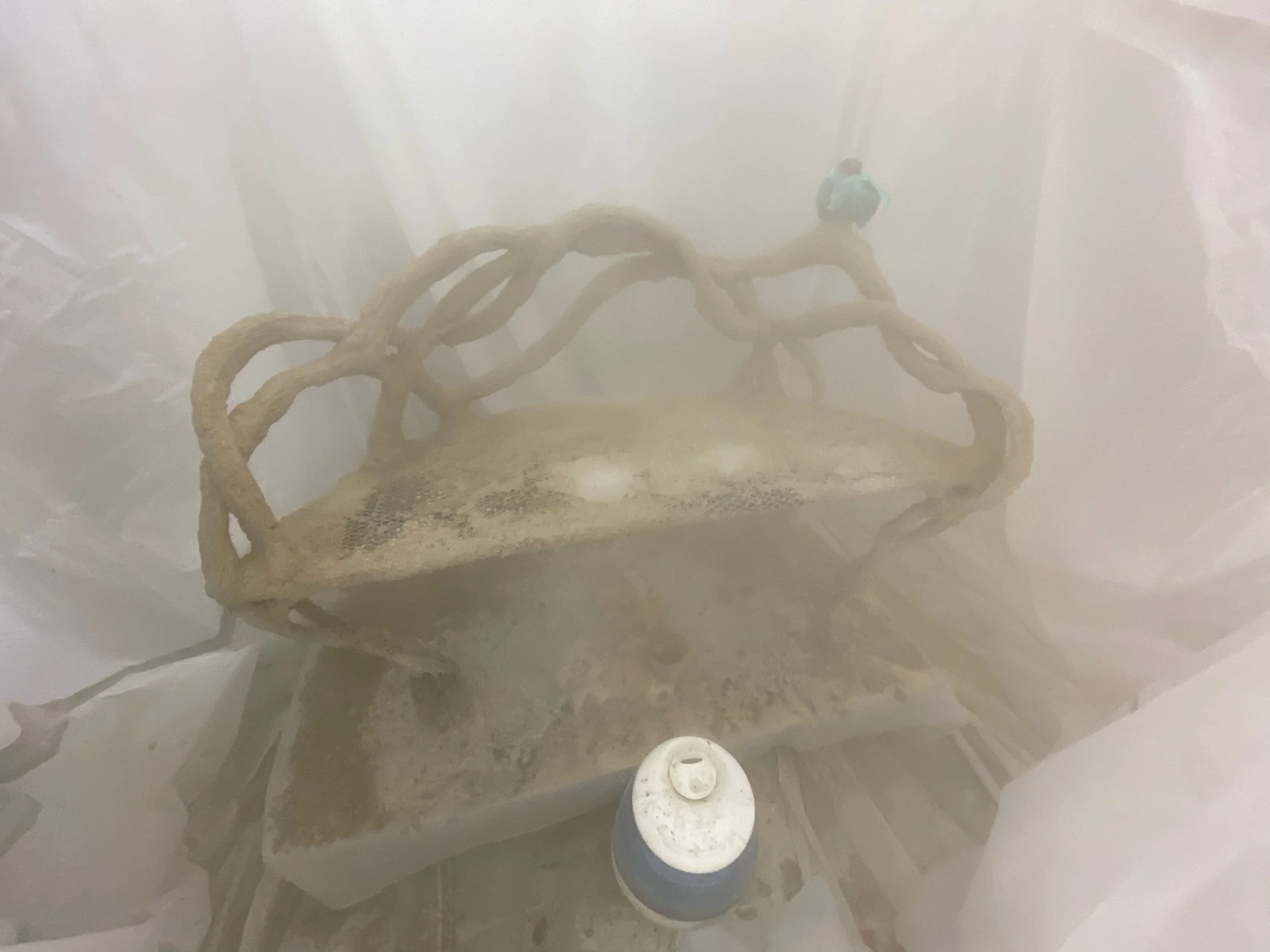
The piece will hydrate for 5 days. If it dries too quickly the concrete will crack. I (actually we, Curtis helped me) build a cube out of pvc. I covered it in heavy sheets of plastic that I cut and sewed to fit the cube. I then installed two construction zippers to allow me to get in and check the humidity. I put a humidifier in the cube with the bench, the humidifier keeps the concrete very moist.
Today I started to prepare the dry ingredients so that I can mix the concrete tomorrow morning.
I prepared 30 lbs. of dry ingredients, 10 pounds of fly ash and 20 lbs. of white concrete. And then I panicked - is the piece in white concrete or is it in grey? With the fly ash mixed with the concrete and the piece being wet, I can not determine what color it is. Yikes! this is a problem. I decided to mix a second bucket of dry ingredients. Tomorrow I will be ready for anything.
Another day of social distancing and not being able to get in my studio. Today's stitching, I added the first of several sweat bees. In reality, they are only about 1/4 ” long. They have beautiful metallic greens and blues. I am working to show more time and movement in my stitching.

I added a tiny sweat bee - he is moving fast and as a result blurry

First I cut some thread of the colors I want the bee to be.

Next I wad them up into a cocoon.

Then I untangle them into the shape of the movement of a bee.

Then I stitch them into the shape of the movement.
This summer it came to my attention that the River oaks Garden Club was having a luncheon with a bee theme. I quickly reached out to their luncheon Chair and she connected me to their environmental chairman. They came to my studio and we talked about the 4,000 wild bees species and how most people only know about honey bees.
Long story short I was invited to talk about the bees at their annual Azalea trail fundraiser. They were Slammed with people. I spoke none stop on Sunday from 11-5.
In addition the environmental chairs decided to work the native bee (the endangered bees) story into their both at their garden show this spring. It is organizations and ladies like these that can save the wild bees.


Image courtesy of Janna Webber


